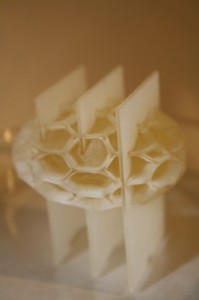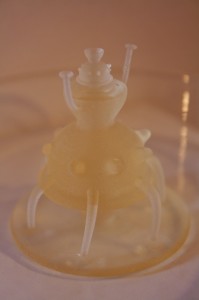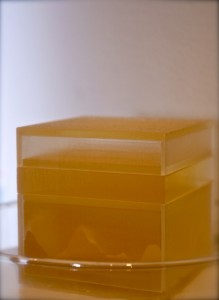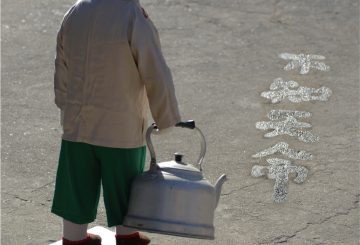The mysteriously-monikered MMacNeill discovers a delightful exhibition of sculptural miniatures that imply much bigger things…
While both exhibitions currently showing at Object/Australian Centre for Craft and Design – Mind and Matter and InsideOut – successfully demonstrate the capacities of sculpture to defy its own material qualities, the intricacies and strangely symphonic qualities of that material may provide profound satisfactions for a viewer with a little extra time to spend.
InsideOut is a variously sponsored, collaborative international project by forty-six artists/designers currently working in analogue and digital media in Australia, New Zealand and the UK (information on participating artists and institutions is available here).
The brief was to produce a three-dimensional sculpture 6 cm x 6 cm x 6 cm, with interpretive latitude given to the theme, InsideOut, to be realised within a specific set of constraints and guidelines: the work was to be “entirely generated through 3D visualisation and modelling tools”, and the computer-generated data files corresponding to it were to be sent to a ‘reciprocal’ country to be transmuted from “virtual to physical” – that is to say, ‘printed’ into a three-dimensional resin object via the technique of stereo-lithography (a digital casting technique whose final stage involves the manual scraping out of the softer mould encasing the resin form).
The upshot is that a modest mezzanine has been converted into a grand space by means of the illusionistic and diminutive scale of a series of exquisite, pristine objects which, while managing the barest material existence in the translucence of their common medium, eloquently sketch out a vast panorama of concepts, narratives and preoccupations belied by their minute scale and spun-sugar lightness of being.
Yet it would be facile to respond to this disparate array of intriguing miniatures as mere maquettes or models; emerging triumphant from rigorous conceptual and methodological origins they assert their grace and integrity both as individual, bespoke elements and as a serene, coherent whole by virtue of the very conditions of their existence. An atmospheric unity is wrought by virtue of these creative constraints, with each sculptural element expressive of its own unique inspiration and conception, imagined form, and degree of inscrutability.
Still, references to monumentality abound, and several sculptures – a few perhaps intentionally so – lend themselves naturally to being recast as large-scale works: at least one springs to mind as warranting reduplication on a grand scale to best articulate what is at present (although already masterfully realised and finessed) a barely perceptible, intrinsic dialectical tension between solidity and ethereality. Thus ready associations with scaled-up versions are inevitable, together with a vague notion that mundane logistical and engineering issues would be seamlessly resolved by virtue of the precise, computer-generated nature of their creation in the first instance.
Given that each sculpture offers up its own distinct and unique pleasures in the viewing, one might venture to comment on individual works. Yet upon reflection this seems like effrontery or even an unwanted intrusion, as if one might break the spell or inadvertently rent the conceptual gossamer that unifies the works, thereby traducing the subjective experience.
A visit to this exhibition is certain to reward the viewer willing to surrender to the charm of these pristine, witty and sometimes philosophical objects: beguiling and puzzling forms within forms, dendritic traceries and balletic whirls, geodesic and geometric puzzles, ironic allusions to scientific measurement and the robotic age, nods to organic life and neurobiology, prehistoric landscapes, ancient mythologies, contemporary fables, and anxious reflections upon the indifferent cruelties of nature; even a gaggle of tiny winged busts rewards the viewer who allows him- or herself to engage with minutiae as a child might – not frenetically as with the handheld technologies – but with the kind of quiet absorption in one’s physical surroundings that transcends time, eludes the social tyrannies, and encourages reflection.
By dint of the collaborative processes of InsideOut from conception to realisation, there is an implicit repudiation both of the artist as socially isolated and of the clamorous narcissism of the age: the individual is by no means subsumed by co-operative endeavours but is, rather, fortified and enhanced by them. Perhaps this venturesome spirit is best encapsulated in a gently ironic piece that slips the yoke of strictly cubic dimensions to depict in linear, cinematic and graffitist form: the brainwave of a monk meditating on unconditional loving-kindness and compassion.
There is much to commend this exhibition. In the spare beauty of its reflexive geometric forms, the strangeness of its hybrid, mutant and evolutionary emergences, the psychological eloquence of its figurative presences, the unexpected symbolic scope of its narratives and its playful hints of surprises for the curious, Matisse‘s view of art’s overriding purpose to elevate the spirit and transcend mundane existence is recalled. Most significantly – and perhaps underscored by the unalloyed stamp of the individual artist or collaboration upon each work – it is here again made clear that neither abstraction nor the illusory powers of scale and perspective can neutralise our fundamental emotional response to a work of art, nor diminish its authorial claims to freedom of both intent and interpretation.
InsideOut may also allay concerns that digital technologies threaten the loss of the artisanal values traditionally obtaining between artists and the chosen media through which they render their concerns and make their art. What has been demonstrated unequivocally – and is perhaps a mark of the success of this exhibition – is that the relation between the artist and the new media is a robust and serendipitous one, offering boundless scope for conceptual and aesthetic innovation and originality.
While it may lack the spectacular obviousness of certain Biennale offerings, this meticulously realised international collaboration – in its own modest way – subtly and deftly breaks the mould to proclaim substantial new ground and rich new fields to mine.
InsideOut
‘Object’/Australian Centre for Craft and Design
Until July 25.




